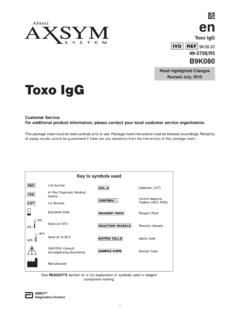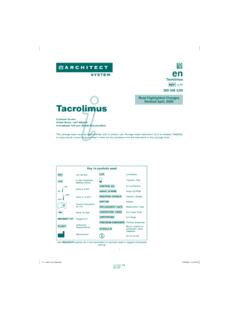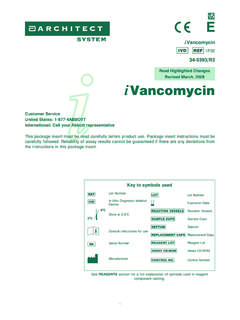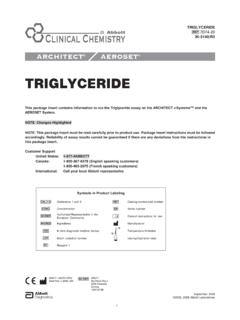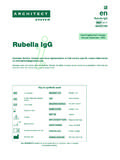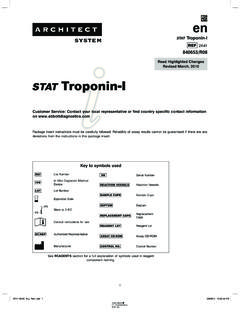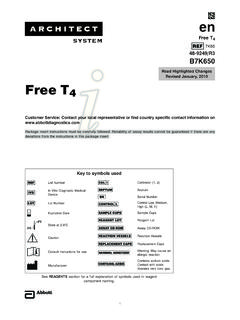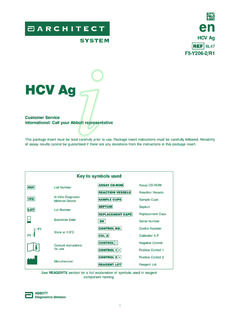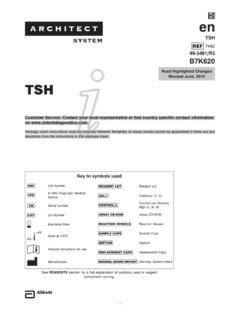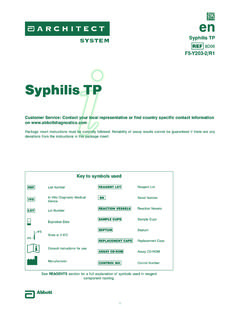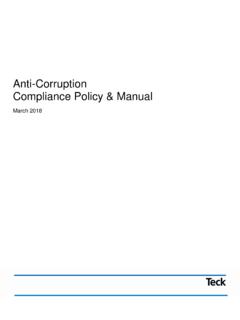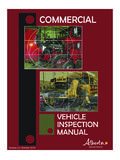Transcription of STAT CK-MB - Ilex Medical Ltd.
1 1840279/R3 2K42 ESTAT CK-MBABBOTTD iagnostics DivisionKey to symbols usedList NumberIn Vitro Diagnostic Medical DeviceStore at 2-8 CConsult instructions for useSerial NumberAuthorized RepresentativeManufacturerLot NumberExpiration DateReaction VesselsSample CupsSeptumReplacement CapsReagent LotAssay CD-ROMC ontrol NumberSee REAGENTS section for a full explanation of symbols used in reagent component CK-MBsystemCustomer ServiceUnited States: 1-877-4 ABBOTTI nternational: Call your Abbott RepresentativeThis package insert must be read carefully prior to use. Package insert instructions must be followed accordingly. Reliability of assay results cannot be guaranteed if there are any deviations from the instructions in this package STAT CK-MBINTENDED USEARCHITECT STAT CK-MB is a Chemiluminescent Microparticle Immunoassay (CMIA) for the quantitative determination of the MB isoenzyme of creatine kinase ( CK-MB ) in human serum and plasma on the ARCHITECT i System with STAT protocol capability.
2 CK-MB values are used to assist in the diagnosis of myocardial infarction (MI).SUMMARY AND EXPLANATION OF TESTCK-MB is an 84,000 molecular weight enzyme that represents a significant fraction of the creatine kinase present in myocardial ,2 CK-MB is also present in a variety of other tissues, although at much lower The appearance of CK-MB in serum, in the absence of major muscle trauma, may be indicative of cardiac damage and thus, myocardial infarction (MI).6,7 MI is defined as myocardial cell death due to prolonged The magnitude and temporal course of CK-MB elevation and decline may clarify the timing of the myocardial insult, allow an estimate of infarct size, and contribute to the non-invasive assessment of PRINCIPLES OF THE PROCEDUREThe ARCHITECT STAT CK-MB assay is a two-step assay to determine the presence of the MB isoenzyme of creatine kinase ( CK-MB ) in human serum and plasma using CMIA technology with flexible assay protocols, referred to as the first step, sample and anti- CK-MB coated paramagnetic microparticles are combined.
3 CK-MB present in the sample binds to the anti- CK-MB coated microparticles. After incubation and washing, anti- CK-MB acridinium-labeled conjugate is added in the second step. Following another incubation and wash, pre-trigger and trigger solutions are added to the reaction mixture. The resulting chemiluminescent reaction is measured as relative light units (RLUs). A direct relationship exists between the amount of CK-MB in the sample and the RLUs detected by the ARCHITECT i* System additional information on system and assay technology, refer to the ARCHITECT System Operations Manual, Section = immunoassayREAGENTSR eagent Kit, 100 Tests/500 TestsNOTE: Some kit sizes are not available in all countries or for use on all ARCHITECT i Systems. Please contact your local STAT CK-MB Reagent Kit (2K42) 1 or 4 Bottles ( mL) Anti- CK-MB (mouse, monoclonal) coated microparticles in TRIS buffer with protein (bovine) stabilizer.
4 Preservatives: antimicrobial agents. 1 or 4 Bottles ( mL) Anti- CK-MB (mouse, monoclonal) acridinium-labeled conjugate in MES buffer with protein (bovine) stabilizer. Preservatives: antimicrobial ReagentsARCHITECT i Pre-Trigger Solution Pre-Trigger Solution containing (w/v) hydrogen i Trigger Solution Trigger Solution containing N sodium i Wash Buffer Wash Buffer containing phosphate buffered saline solution. Preservative: antimicrobial AND PRECAUTIONSFor In Vitro Diagnostic PrecautionsCAUTION: This product requires the handling of human specimens. It is recommended that all human sourced materials are considered potentially infectious and be handled in accordance with the OSHA Standard on Bloodborne Biosafety Level 211 or other appropriate biosafety practices12,13 should be used for materials that contain or are suspected of containing infectious product not classified as dangerous per European Directive 1999/45/EC as amended - Safety data sheet available for professional user on a detailed discussion of safety precautions during system operation, refer to the ARCHITECT System Operations Manual, Section 8.
5 * Handling PrecautionsDo not use reagent kits beyond the expiration not pool reagents within a kit or between reagent to loading the ARCHITECT STAT CK-MB Reagent Kit on the system for the first time, the microparticle bottle requires mixing to resuspend microparticles that have settled during shipment. For microparticle mixing instructions, refer to the PROCEDURE, Assay Procedure section of this package MUST be used to prevent reagent evaporation and contamination and to ensure reagent integrity. Reliability of assay results cannot be guaranteed if septums are not used according to the instructions in this package avoid contamination, wear clean gloves when placing a septum on an uncapped reagent to placing the septum on an uncapped reagent bottle, squeeze the septum in half to confirm that the slits are open. If the slits appear sealed, continue to gently squeeze the septum to open the a septum has been placed on an open reagent bottle, do not invert the bottle as this will result in reagent leakage and may compromise assay time, residual liquids may dry on the septum surface.
6 These are typically dried salts which have no effect on assay a detailed discussion of handling precautions during system operation, refer to the ARCHITECT System Operations Manual, Section InstructionsThe ARCHITECT STAT CK-MB Reagent Kit must be stored at 2-8 C in an upright position and may be used immediately after removal from 2-8 C stored and handled as directed, reagents are stable until the expiration ARCHITECT STAT CK-MB Reagent Kit may be stored on board the ARCHITECT i System with STAT protocol capability for a maximum of 30 days. After 30 days, the reagent kit must be discarded. For information on tracking on-board time, refer to the ARCHITECT System Operations Manual, Section may be stored on or off the ARCHITECT i System. If reagents are removed from the system, store them at 2-8 C (with septums and replacement caps) in an upright position. For reagents stored off the system, it is recommended that they be stored in their original trays and boxes to ensure they remain upright.
7 If the microparticle bottle does not remain upright (with a septum installed) while in refrigerated storage off the system, the reagent kit must be discarded. After reagents are removed from the system, you must initiate a scan to update the on-board stability of Reagent DeteriorationWhen a control value is out of the specified range, it may indicate deterioration of the reagents or errors in technique. Associated test results may be invalid and may require retesting. Assay recalibration may be necessary. For troubleshooting information, refer to the ARCHITECT System Operations Manual, Section PROCEDUREThe ARCHITECT STAT CK-MB assay file must be installed on the ARCHITECT i System with STAT protocol capability from the ARCHITECT i Assay CD-ROM Addition B prior to performing the assay. For detailed information on assay file installation and on viewing and editing assay parameters, refer to the ARCHITECT System Operations Manual, Section information on printing assay parameters, refer to the ARCHITECT System Operations Manual, Section a detailed description of system procedures, refer to the ARCHITECT System Operations default result unit for the ARCHITECT STAT CK-MB assay is ng/mL.
8 An alternate result unit, g/L, may be selected for reporting results by editing assay parameter Result concentration units to g/L. The conversion factor used by the system is 3 SPECIMEN COLLECTION AND PREPARATION FOR ANALYSISThe following specimen collection tubes may be used in the ARCHITECT STAT CK-MB No additive (uncoated) Serum separator tubesPlasma Lithium heparin Lithium heparin Plasma separator tubes with lithium heparin Plasma separator tubes with lithium heparin Sodium heparinNOTE: Evaluation of serum samples may result in up to a -18% bias compared with plasma samples. When serial specimens are being evaluated, the same type of specimen should be used throughout the anticoagulants have not been validated for use with the ARCHITECT STAT CK-MB assay. Follow the manufacturer s processing instructions for plasma or serum collection ARCHITECT i System does not provide the capability to verify specimen type.
9 It is the responsibility of the operator to verify the correct specimen types are used in the ARCHITECT STAT CK-MB not use heat-inactivated has not been established using cadaver specimens or body fluids other than human serum or with obvious microbial contamination should not be caution when handling patient specimens to prevent cross contamination. Use of disposable pipettes or pipette tips is all samples for bubbles. Remove bubbles with an applicator stick prior to analysis. Use a new applicator stick for each sample to prevent cross and serum specimens should be free of fibrin, red blood cells or other particulate that complete clot formation in serum specimens has taken place prior to centrifugation. Some specimens, especially those from patients receiving anticoagulant or thrombolytic therapy, may exhibit increased clotting time. If the specimen is centrifuged before a complete clot forms, the presence of fibrin may cause erroneous specimens with a cloudy or turbid appearance must be centrifuged prior to testing.
10 Following centrifugation, avoid the lipid layer, if present, when pipetting the testing will be delayed more than 8 hours, remove plasma or serum from the red blood cells, clot or separator gel. Specimens removed from the red blood cells, clot or separator gel may be stored up to 72 hours at 2-8 can be stored up to 30 days frozen at -10 C or must be mixed THOROUGHLY after thawing, by LOW speed vortex or by gentle inversion, and centrifuged prior to use to remove red blood cells or particulate matter to ensure consistency in the results. Multiple freeze-thaw cycles of specimens should be samples (patient specimens, controls, and calibrators) should be tested within 3 hours of being placed on board the ARCHITECT i System. Refer to the ARCHITECT System Operations Manual, Section 5, for a more detailed discussion of on-board sample storage constraints. When shipped, specimens must be packaged and labeled in compliance with applicable state, federal and international regulations covering the transport of clinical specimens and infectious substances.
